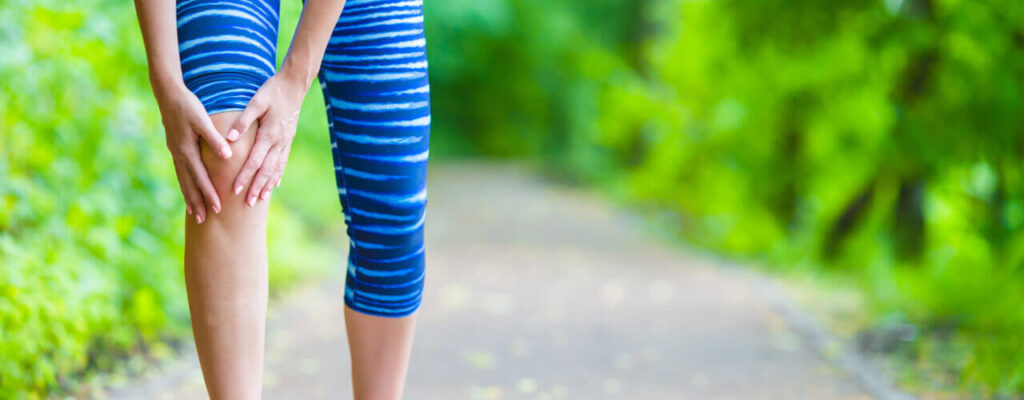Ready to Kick Hip and Knee Pain? We Can Help!

Move More Comfortably with Physical Therapy Treatments!
Are your weight-bearing joints acting more like pain-bearing joints these days? If you have a hip or knee that can’t support your body weight without causing annoying aches or agonizing pain, you may not be able to do your job, play sports, do household chores, or even find a comfortable sitting or sleeping position.
These limitations and frustrations may have you tossing back pain relief drugs or considering joint replacement surgery. Luckily, many causes of hip and knee pain respond quite well to physical therapy – a natural approach to pain management.
How can physical therapy help with hip and knee pains?
Getting relief from knee or hip pain doesn’t necessarily involve the use of heavy drugs such as opiates or procedures such as joint replacement surgery. Physical therapy can improve your joint function while also easing your pain and stiffness.
Our physical therapist can prescribe exercises aimed at addressing your specific condition, such as:
- Step exercises
- Hamstring curls
- Leg lifts
- Hip flexion, extension, or abductor exercises
- Mini-squats
- Heel-to-buttock-exercises
- Hip rotations
- Knee lifts
Even an activity as simple as walking to help preserve mobility and reduce pain in arthritic knees or hips. Our physical therapist may also recommend that you receive heat/ice therapy, ultrasound therapy, massage therapy, laser therapy, or orthotic footwear to help normalize your musculoskeletal balance.
Your pain might feel overwhelming, but no matter what condition you’re suffering from, a physical therapist can help relieve your pain.
Your movement specialist will assess your condition, medical history, and pain levels to create a specialized program that meets your exact needs.
Read on to learn more about common treatment methods a physical therapist might use to reduce and relieve hip and knee pain:
- Ultrasound Therapy – Ultrasound therapy can be used in physical therapy to provide soothing heat to deep tissues. A licensed physical therapist can also utilize ultrasound technology to easily identify specific areas of pain.
- Laser Therapy – Laser therapy has become much more popular in physical therapy for pain management. It can help improve the growth and reproduction of cells, increase circulation, and also reduce inflammation.
- Manual Physical Therapy – Hands-on techniques are used often in physical therapy to reduce pain in your hips and knees. This could include stretching exercises or a variety of massage techniques.
- Ice & Heat – A physical therapist may use ice packs to reduce swelling and inflammation. Heat is also commonly used during physical therapy to help increase mobility and reduce pain.
- At-Home Exercises – Did you know you don’t always have to be in a clinical setting to do physical therapy exercises? It’s true! Physical therapy techniques can be incorporated into a home exercise program that can become part of your daily routine.
What’s causing my hip and knee pain?
Your hips and knees do a lot of work over the course of a lifetime. These joints must withstand the majority of your body weight – not just when you’re standing still, but also as you walk, run, climb or jump. It’s not surprising, then, that a variety of ailments and injuries can plague the knee and hip joints.
Your pain and stiffness may be caused by:
- Runner’s knee – An unstable kneecap can lead to chronic knee pain. This condition is known as patellofemoral syndrome or “runner’s knee.”
- Sprains, strains, and ruptures – The knee and hip joints can move thanks to muscles, tendons and ligaments. Repetitive motion or acute injuries can cause a strain (damage to muscles or tendons) or a sprain (hyperextension of a ligament). Athletes are vulnerable to ruptures of the ACL (anterior cruciate ligament).
- Bursitis – Both the hips and knees have fluid-filled sacs called bursae that prevent friction between bones and soft tissues. Unfortunately, these sacs can become inflamed from overuse, a painful condition called bursitis.
- Osteoarthritis – Osteoarthritis is a degeneration of the cartilage that normally keeps the bone ends in a joint from rubbing together. The resulting friction causes chronic pain and inflammation.
Various health or lifestyle challenges can worsen a case of hip or knee pain. Carrying extra weight is a prime example. A musculoskeletal misalignment or postural imbalance can place unnatural stress on a hip or knee. Lack of exercise can allow the muscles to weaken, setting the stage for chronic strain and joint instability.
Find effective relief with physical therapy!
The sooner you get physical therapy for knee or hip pain, the better. Research shows that patients who rehabilitate their hip or knee pain with physical therapy within 15 days of the onset of symptoms have less need for pain injections, medications, or surgery.
But whatever stage of pain you’re in, it’s never too late to take advantage of physical therapy. Please contact Chiron Physical Therapy to get started!


